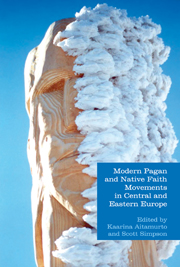Book contents
- Frontmatter
- Contents
- Contributors
- 1 Introduction: Modern Pagan and Native Faith Movements in Central and Eastern Europe
- Part I Overviews
- 2 A Postcolonial Key to Understanding Central and Eastern European Neopaganisms
- 3 Selected Words for Modern Pagan and Native Faith Movements in Central and Eastern Europe
- 4 Romanticism and the Rise of Neopaganism in Nineteenth-Century Central and Eastern Europe: the Polish Case
- 5 Russian Neopaganism: from Ethnic Religion to Racial Violence
- Part I Country Studies
- Part III Thematic Studies
- Bibliography
- Index
2 - A Postcolonial Key to Understanding Central and Eastern European Neopaganisms
from Part I - Overviews
- Frontmatter
- Contents
- Contributors
- 1 Introduction: Modern Pagan and Native Faith Movements in Central and Eastern Europe
- Part I Overviews
- 2 A Postcolonial Key to Understanding Central and Eastern European Neopaganisms
- 3 Selected Words for Modern Pagan and Native Faith Movements in Central and Eastern Europe
- 4 Romanticism and the Rise of Neopaganism in Nineteenth-Century Central and Eastern Europe: the Polish Case
- 5 Russian Neopaganism: from Ethnic Religion to Racial Violence
- Part I Country Studies
- Part III Thematic Studies
- Bibliography
- Index
Summary
This chapter attempts to provide a theoretical framework for the analysis of those Neopagan groups which emerged in the wake of the turbulent political changes in the late 1980s in Central and Eastern Europe (CEE). It explores to what extent the centuries-long experience of foreign domination in the countries of CEE is an important factor shaping the dynamic of native religions. At the same time, the article suggests that the post-Enlightenment invention of Eastern Europe, and the subsequent split between the western and the Eastern part of the continent, have also contributed to the differences between the native religions and esoteric Paganism in Western Europe. Finally, the article tries to clarify to what extent the postcolonial theory provides a useful theoretical framework to grasp the nature of native religion and whether the interest of Hindu groups from India in native religions can be considered as a proof in support of this hypothesis.
The chapter focuses on the autochthonic groups that call themselves “native religion” and claim to represent local spiritual traditions. Those groups and movements that are clearly cultural importations and are based on traditions or concepts originated elsewhere than in CEE are left beyond the scope of this chapter.
To clarify the scope of the chapter and to specify which groups fall into the category of ethnic religions, the following characteristic features of such groups can be discerned. First, they represent polytheism (or henotheism) and the plurality of spiritual forces or deities are their distinct difference from the established religions.
- Type
- Chapter
- Information
- Publisher: Acumen PublishingPrint publication year: 2013



